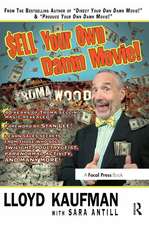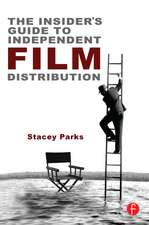The Cinema of Gosho Heinosuke – Laughter through Tears
Autor Arthur Nolletti Jr.en Limba Engleză Paperback – 14 apr 2005
Through close readings of the most significant films of Gosho Heinosuke and descriptions of their historical, social, and industrial contexts, Arthur Nolletti illuminates the work of this important director. The careful attention Gosho gave to even the smallest gestures and nuances of character and emotion is matched by the breadth of Nolletti s research and the depth of his understanding. His analysis illustrates the important influence of Gosho s unique style and sensibility on cinematic form in Japan and beyond."
Preț: 246.56 lei
Nou
Puncte Express: 370
Preț estimativ în valută:
47.18€ • 49.39$ • 39.04£
47.18€ • 49.39$ • 39.04£
Carte tipărită la comandă
Livrare economică 05-19 aprilie
Preluare comenzi: 021 569.72.76
Specificații
ISBN-13: 9780253217257
ISBN-10: 0253217253
Pagini: 352
Ilustrații: 37 b&w illustrations
Dimensiuni: 156 x 235 x 15 mm
Greutate: 0.59 kg
Editura: MH – Indiana University Press
ISBN-10: 0253217253
Pagini: 352
Ilustrații: 37 b&w illustrations
Dimensiuni: 156 x 235 x 15 mm
Greutate: 0.59 kg
Editura: MH – Indiana University Press
Cuprins
Acknowledgments
Introduction
1. Gosho and Shomin Comedy in the 1930s
2. Dancing Girl of Izu (1933) and the Junbungaku Movement
3. Woman of the Mist (1936): Blending the Shomin-geki, Shitamachi, and Romantic Melodrama
4. Once More (1947) and Gosho's Romanticism in the Early Occupation Period
5. Where Chimneys Are Seen (1953): A New Kind of Shomin-geki
6. An Inn at Osaka (1954): Money, Democracy, and Limited Knowledge
7. Growing Up (1955): Adapting the Meiji-mono, Reconfiguring the Shomin-geki
8. The Late 1950s: New Challenges and the Quest to Create
9. Gosho in the 1960s: Changing Times, Undiminished Mastery
Appendix: Three Films
Notes
Filmography: Gosho Heinosuke
Selected Bibliography
Index
Introduction
1. Gosho and Shomin Comedy in the 1930s
2. Dancing Girl of Izu (1933) and the Junbungaku Movement
3. Woman of the Mist (1936): Blending the Shomin-geki, Shitamachi, and Romantic Melodrama
4. Once More (1947) and Gosho's Romanticism in the Early Occupation Period
5. Where Chimneys Are Seen (1953): A New Kind of Shomin-geki
6. An Inn at Osaka (1954): Money, Democracy, and Limited Knowledge
7. Growing Up (1955): Adapting the Meiji-mono, Reconfiguring the Shomin-geki
8. The Late 1950s: New Challenges and the Quest to Create
9. Gosho in the 1960s: Changing Times, Undiminished Mastery
Appendix: Three Films
Notes
Filmography: Gosho Heinosuke
Selected Bibliography
Index
Recenzii
The elegant, graceful, and deeply humanistic cinema of Gosho Heinosuke has found its perfect English-language explication in this equally elegant, graceful, and humanistic study by Arthur Nolletti. A director of wide-ranging interests, Gosho was at his strongest in stories of ordinary Japanese life. Like Mizoguchi he had a particular strength and sensitivity to womens issues; like Ozu he was a delicate yet piercing commentator on middle-class life. But he had a voice and style of his own, and Nolletti is careful to define and describe this sensibility in telling detail. David Desser
Notă biografică
Arthur Nolletti, Jr.
Descriere
The first book-length work in English of one of the most important directors of the Golden Age of Japanese cinema




















